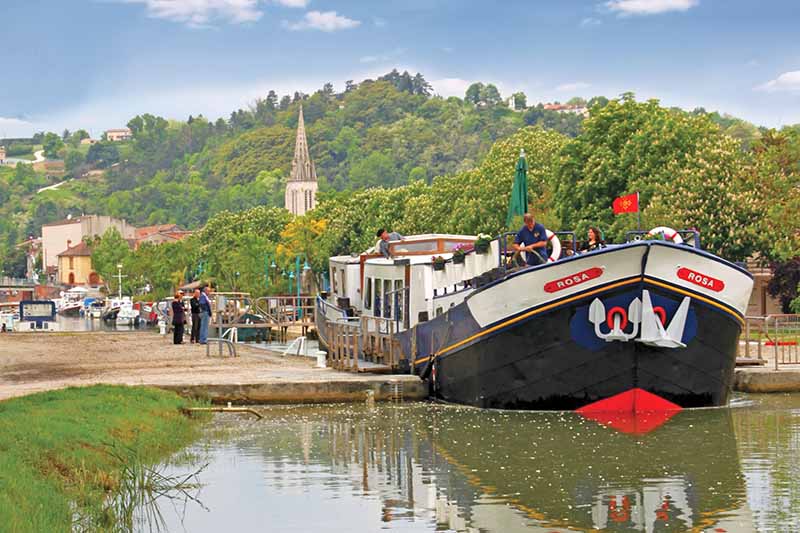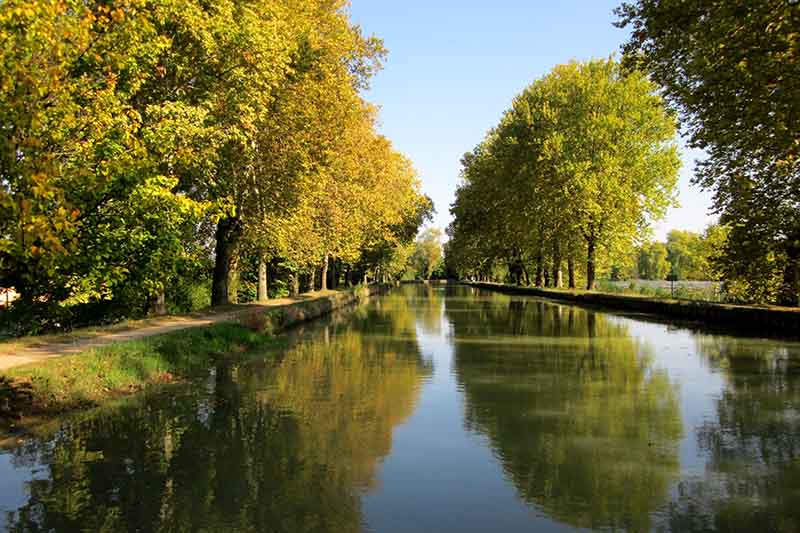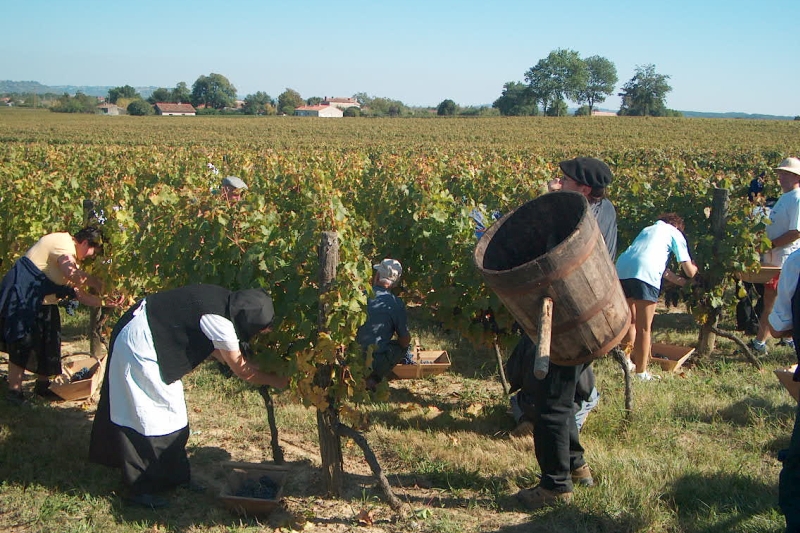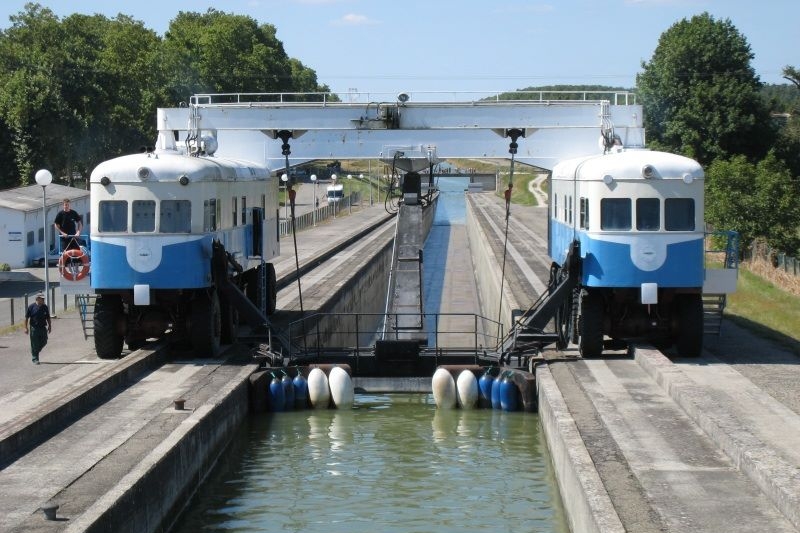Part 1: The Canal de Garonne – An Overview
The Canal de Garonne (120 miles, 53 locks) stretches from its junction with the Canal du Midi in Toulouse, west to Castets-en-Dorthe where it opens into the tidal Garonne River. The port of Castets used to be very busy with barges queuing up, waiting for high tide so they could continue with their cargo on to Bordeaux. The canal is part of a route dissecting the south of France which allows boats to pass directly between the Mediterranean and the Atlantic without circumnavigating Spain and through the Strait of Gibraltar, where Barbary Pirates were rife during the 17th century. The Canal des Deux Mers is the name now commonly used for the entire navigable route, including the Canal du Midi, which extends for nearly 370 miles from Bordeaux to Sète.
Work on the 19th century Canal de Garonne did not start until 1838, nearly 150 years after the Canal du Midi was already in use. As was the case with other parts of the French canal network, the advent of the railway soon affected its use for the commercial transport of goods.
Unlike the earlier Canal du Midi, the Canal de Garonne features many straight stretches, and between Toulouse and Agen the railway is always nearby. The area around Agen is a bountiful fruit-growing region of France, with strawberries, cherries, apples, pears, plums and peaches grown in the vicinity. In early summer, the banks come alive with yellow iris which welcome passing boats. The canal also sports the world’s first “water slope,” built in 1974 at Montech to replace a flight of locks. Two other engineering marvels and impressive structures are the aqueducts over the Tarn near Moissac and over the Garonne at Agen.
Part 2: Towns & Villages
There are many great towns around the Canal de Garonne and one of the best is Buzet-sur-Baïsse. It was a community of villas and farms built by the Romans high up in the hills and terraces surrounding the village. In the Middle Ages, a small town had started to develop around the 13th century castle, which to this day sits atop a rocky spur overlooking the valleys of Bénac and Baïsse.
There were likely many noble families, each of whom had a building. Of these buildings, two remain: a tower in the estate of the current château and another castle, which has been attributed to the 15th century. Towards the end of the Middle Ages, only one lord remained, who worked on modernising the Château de Buzet by adding two new towers, two spiral staircases and, in the 18th century, two new wings which have since disappeared. Noble families continued to occupy the castle until 1929. In 2018 it was acquired by the Cave des Vignerons de Buzet.
Towards the end of the Wars of Religion in the 16th century, the small hamlet of wine growers developed beside Bénac brook. The main activity of the area has always been agriculture, viticulture in particular. There was also much flour milling activity in the various mills of Bénac stream, and especially at the Mill in Baïsse. In the aftermath of the First World War, the mill was converted into a pencil factory and this new industry then made Buzet known throughout France. In the 1960s production ceased, and the building abandoned.
Buzet is now known the world over for the Cave des Vignerons, which started in the 1950s thanks to the will of a handful of winemakers who wanted to free themselves from the support of traders.
It is a success both qualitative and commercial, beyond the expectations of its creators. The cooperage of the town is also a stage for the ballet-like “art” of barrel-making.
Located on the Garonne River, Agen is a good-sized town and the attractive provincial capital, Pont-Canal d’Agen, spans the Garonne covering a distance of one-third of a mile. The stone aqueduct is made up of 23 basket-handle arches on 22 pillars.
Agen is the prune production centre of France, sometimes jokingly named the Capital of Prunes. It cultivates vast orchards of plum trees, brought to France in the 11th century by crusaders returning from the Middle East. The town is also a mecca for rugby with the local team, SU Agen, playing in the topflight of professional French rugby.
Lamagistère is on the River Garonne, overlooked by the hilltop village of Clermont Soubiran. During the WWII, Lamagistère was at the centre of a joint Franco-American operation to sabotage vital railway lines between Toulouse and Bordeaux. The railway was heavily defended by a German garrison, and the operation is still one of the little-known episodes of the French Resistance.
Moissac is considered by many to be the most beautiful and interesting of the towns on the Canal de Garonne, with thanks to its staircase of locks decorated with flowers. Moissac is also home to the ancient 7th century Abbey of St-Pierre, partly Romanesque and partly Gothic, with an impressive carved doorway on the south side.
Nearby is the birthplace of M. de la Mothe Cadillac, who founded Detroit and, of course, gave his name to the famous luxury car. The town is also known for its golden dessert grapes.
Valence d’Agen, built in 1283 by Edward I of England, is a large thriving market town which is also an ancient bastide. It has an impressive canal side public wash house.
Castelsarrasin, set amidst scattered fields and orchards, played an important part during the Hundred Years’ War. Of interest is part of its fortifications and St-Saviour’s Church with its superb Baroque furniture (17th and 18th century). Equally charming are the floral decorations that adorn the town, for which it has been awarded a number of accolades.
Montech is a village with a 15th century church. Surrounding it is Montech Forest, a dense, old woodland covering 1,460 hectares (3,607 acres), providing a wonderful place for horse riding, cycling, or hiking. The short Canal de Montech cuts through the forest and has nine charming lock-keeper’s houses.
The Montech Water Slope was built in 1974 and is a unique structure. The water is trapped within three walls – the two sides and the lower gate – and the triangular “bath” that is formed by this, then slides up a 3° slope, taking both the water and a boat with it, for an elevation change of 43 feet. The water slope allowed barges to bypass a five-lock flight spread over 1¼ miles, until it suffered a mechanical failure in 2009. It has been out of service since, but there are reports that it will soon be recommissioned. It’s an impressive sight with is worth a visit when cruising the Canal de Garonne.
The city of Toulouse is a major industrial and university city, the capital of the Midi-Pyrénées, and the fourth largest city in France. Most travellers who cruise the Canal de Garonne will pass thought this charming city at some point during their visit.
Known as La Ville Rose, or the Pink City due to its weathered red brick buildings, it is only 60 miles from the border with Spain. Toulouse’s site, on the banks of the Garonne, dates from the 4th century BC when it was founded by the Aquitani tribe. It was later part of Roman Gaul and became a separate country in 843 AD. The rich history of Toulouse is reflected in the city’s architectural splendours: the 12th century basilica of St-Sernin is the largest Romanesque church in Western Europe. The church and the cloisters of the Jacobins form the most complete group of monastic structures in France. Also of interest is the St-Étienne cathedral, and the many hotel particuliers – or private mansions – of the Renaissance era. Toulouse has long been a cultural and commercial power, but it has an artistic side to it as well, no doubt fuelled by its large student population. It is a city filled with gardens and squares, delighting those who enjoy strolling, and curiously also boasts 20 historic pipe organs.
Approximately 5 miles northwest of the city, in the suburb of Blagnac, sits the European headquarters of aircraft manufacturer, Airbus. Within the international airport of Toulouse-Blagnac’s perimeter is a fascinating museum, which documents the history of Airbus – Aeroscopia. Its most impressive features are two Concordes, both of which can be visited, a Super Guppy transporter and a replica of the first aeroplane to have crossed the channel in 1909.
Perched on the side of a gorge above the River Garonne, Auvillar is an old toll and merchant-barge port. Considered by some to be one of the most beautiful villages in France, its historic monuments include the 14th century chapel of Saint Catherine, who, along with Saint Nicholas, is the Patron Saint of mariners. A 17th century clock tower houses the barge museum and nearby is the 19th century covered circular grain market.
Within the market there are still two types of grain measure which can be seen; a metal measure and a stone measure, dating from the construction of the original, rectangular building.
The Church of St-Peter dates from 1186. It was partly demolished in the Revolution but has since been rebuilt. Classified an historic monument, it is one of the most beautiful churches in the diocese of Montauban.
According to some, Nérac, on the River Baïsse, once hosted Shakespeare. A further claim is that the banks of the River Baïsse inspired the setting for Love’s Labour Lost. At one time, Nérac was the spiritual and cultural capital of the region. Château de Nérac was the childhood residence of King Henri IV. Wandering around the quaint winding streets, you will discover a wonderful variety of half-timbered and stone houses. Be sure to stroll through the beautiful Parc Royal of Queen Margot when taking a break from cruising the Canal de Garonne.
Vianne, also on the River Baïsse, is another of the historic bastides (see Serignac). Built in 1284, the fortified town still has walls, two corner towers, and four tower gates. Vianne’s famous glassworks led to the growth of many associated crafts such as glazed earthenware production, crystal carving, and glass blowing.
Ready to Explore the Canal de Garonne?
Guests crushing the Canal de Garonne aboard luxury hotel barge Rosa will have the opportunity to visit many of the sites listed above. For more information on our itineraries and the rest of our collection of luxury hotel barge cruises, why not order a free copy of our brochure today or speak to a member of our team directly using our handy Contact Form.
 English
English
 Spanish
Spanish French
French German
German Norwegian
Norwegian Portuguese
Portuguese Swedish
Swedish Italian
Italian Russian
Russian Simplified Chinese
Simplified Chinese Japanese
Japanese






